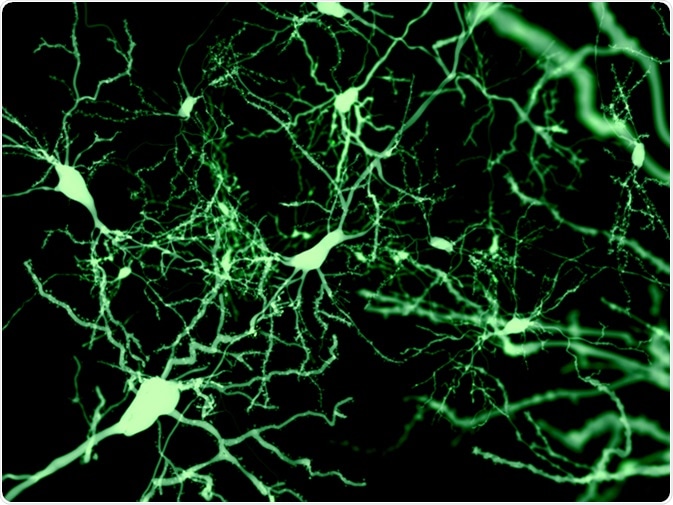Modern instrumental chemical analysis employs a variety of techniques. Fluorescence spectroscopy is one of these methods and is based on the principle of excitation and emission of characteristic radiation by the analyte.
This emission is then examined and the energies and relative intensities of the various parts of the spectrum tell the researcher both the types of molecules present and their concentration and absolute amount.
When a photon of light of the right wavelength is absorbed by a molecule capable of fluorescence (termed a fluorophore), it is referred to as being excited.

Neurons marked by fluorescence. Image Credit: Juan Gaertner / Shutterstock
This causes the electronic state to change from the ground state of maximum stability to one of several excited vibrational levels, most commonly S1. The electron returns to the ground state almost at once, a phenomenon termed relaxation, by one of several processes.
Fluorescence belongs to this category, by which the absorbed radiation is emitted as a photon with energy of a characteristic and longer wavelength than the absorbed photon, in order to help the electron return from the singlet excited state to the singlet ground state. The emitted energy belongs to the visible light spectrum and depends on the energy gap between the two states.
Some energy is lost during vibrational relaxation and reorientation of the solvent molecules during both excitation and relaxation, which accounts for the longer wavelength. The energy balance equation for this process may be depicted as:
E fluor = Eabs − Evib − Esolv.relax.
where Efluor is the energy of the emitted light;
Eabs is the energy of the absorbed light;
Evib is the energy lost during vibrational relaxation;
Esolv.relax is the energy consumed by the reorientation of the solvent molecules.
The spectrum produced by fluorescence reflects various internal transitions between the vibrational levels, each of which again has distinct rotational levels, contributing to a number of absorption bands which make up a broad spectrum.
The difference in the energy of various bands always corresponds to that between the lowest vibrational level of the first excited state, and the ground state, with respect to the emission of light in fluorescence.
This ensures the unchanged shape of the emission spectrum no matter what the wavelength of the exciting light happens to be. Emission may be plotted against wavelength at any excitation wavelength to yield the emission spectrum.
Educational Series: What is Fluorescence Spectroscopy?
Components of a fluorescence spectrometer
This instrument consists of the following parts:
- A sample holder
- A source of incident light such as a xenon lamp
- A monochromator which selects monochromatic light of a specified wavelength
- An emission monochromator or cut-off filter
- Focusing lenses
- Photon-collecting detectors positioned at right angles to the light source to reduce sensitivity by about 10 000 and improve the signal-noise ratio
- Software to analyze the collected data
At a particular wavelength, a fluorescence emission beam is detected and recorded and then plotted as a function of its wavelength. Even non-fluorescent substances may be studied in this manner by using an active label.
Time-integrated laser-induced fluorescence (LIF-t) is an advance in this field which offers greater sensitivity than ever before. It directly senses the emitted radiation from the analyte which is sought to be detected and provides high spatial resolution.
Disadvantages
Fluorescence is a highly sensitive technique and false positives are likely to occur unless precautions are taken to record a genuine signal of the analyte.
Applications
Fluorescence spectroscopy is useful in applications such as detecting and quantifying organic compounds. Industrial applications include testing surface quality and cleanliness, as in processes which involve coating, cleaning, or lubrication of technical surfaces. It leaves the surface intact after testing.
Laser-induced fluorescence spectroscopy uses exciting laser to excite fluorophores in the target molecules which is emitted during relaxation within a span of nanoseconds. This allows even moving surfaces to be scanned accurately.
It is extremely sensitive and can detect microscopic quantities of the analyte to be tested for. The spot size can be adjusted by selecting various positions, distances and angles of the probe from the surface to be tested.
Background fluorescence from organic matter on the surface should be guarded against interfering with the final output data. This helps to assess the efficiency of cleaning processes during each step prior to the next manufacturing process such as annealing, which may be highly dependent upon the absence of contaminants such as lubricants or other process additives.
References
- https://ww1.oswego.edu/
- https://www.photonics.com/Article.aspx?AID=58005
- http://www2.warwick.ac.uk/services/ris/impactinnovation/impact/analyticalguide/fluorescence/https://application.wiley-vch.de/books/sample/3527316698_c01.pdf
- https://www.chem.uci.edu/~dmitryf/manuals/Fundamentals/Fluorescence%20Spectroscopy.pdf
Further Reading